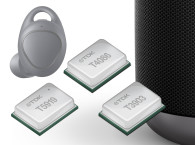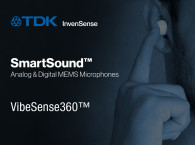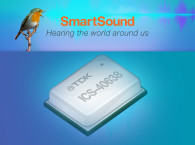
TDK’s new T3902 microphone enables OEM partners to differentiate their product offerings by improving the consumer experience with reduced power consumption. This is especially critical to wearable and connected designs where reduced board space and battery size are key factors to enabling a small form factor as well as providing a flexible and efficient (low power AlwaysOn) system design.
The T3902 is an ultra-low power, low noise, multi-mode bottom-port MEMS microphone, enhancing voice-based services which are now commonplace in many devices and homes. The microphone offers an exceptionally efficient 185 µA ultra-low power mode, in a surface‐mount 3.5 mm x 2.65 mm x 0.98 mm package, which combined with the AlwaysOn functionality in low-power mode enables immediate accessibility upon wake command as required in earbuds and wearables.
“The T3902 is the lowest-power PDM microphone on the market today and has been developed to meet the growing demands of the high performance, ultra-low power audio markets,” says Kieran Harney, Managing Director – Audio Products at InvenSense, a TDK Group company. “With this newest microphone product offering, we continue to be committed to bringing to market a strong portfolio of disruptive, high-performance, innovative products that improve end-user experience and empower new and exciting use cases in IoT and mobile devices for our customers and partners.”
The T3902 consists of a MEMS microphone element and an impedance converter amplifier followed by a fourth‐order Σ‐Δ modulator. The pulse density modulated (PDM) interface allows two microphones to be time multiplexed on a data line using a single clock. This model offers multiple modes of operation: High Performance, Low Power (AlwaysOn), Standard and Sleep, keeping low power and high SNR in all operational modes. It has 126 dB SPL AOP in High Performance mode, and 120 dB SPL AOP in Standard and Low‐Power modes.
TDK T5818 Microphone
This is the second MEMS microphone launched by TDK in 2020, following the introduction of the T5818 model, which the company promotes as the industry’s widest dynamic range PDM microphone, with a dynamic range of 107dB at 590µA, always at the lowest power. This allows for excellent acoustic performance in environments that shift from very quiet to very loud, such as far field voice pickup barge-in for Smart Speaker applications.

The T5818 microphone features 66dBA SNR, 135dB SPL AOP, at 590 µA in High Quality Mode (HQM), and decreases power consumption to 215 µA in Low Power Mode (LPM). This microphone is essential for capturing high quality audio inputs, which plays a vital role for AI engines and cloud-based applications that require a PDM microphone interface. Current analog output wide dynamic range microphones require expensive ADCs to take advantage of full acoustic capabilities. The T5818 provides this ADC conversion while maintaining excellent dynamic range with the benefits of a PDM low latency bit stream. This makes the T5818 suitable for a wide range of applications, from mobile phones to ANC headsets.
www.invensense.tdk.com






